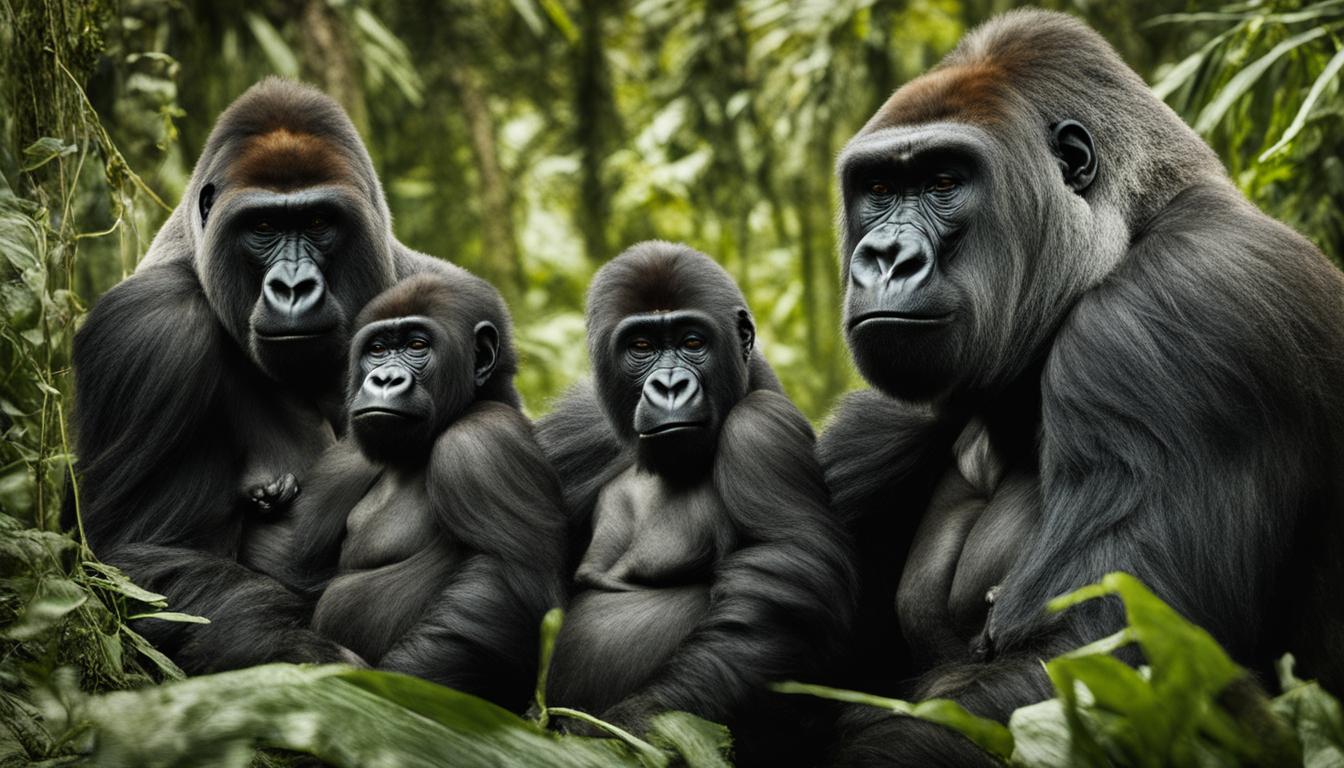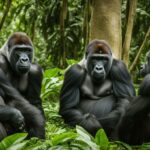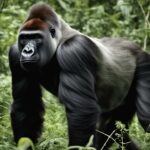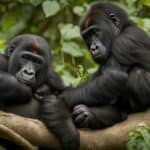When it comes to gorillas, have you ever wondered how long they live in their natural habitat? Understanding the average lifespan of a gorilla is essential for gaining insight into their lives and the challenges they face. So, let’s dive into the world of gorillas and explore their lifespan in the wild.
Gorillas, fascinating creatures known for their strength and intelligence, have an average lifespan of about 35-40 years in the wild. However, it is important to note that some gorillas can live up to 50 years, depending on various factors.
These majestic primates face several challenges that impact their lifespan. Predators, habitat loss, and human activities such as poaching pose significant threats to their survival. In addition, diseases and infectious agents can also affect gorilla populations, further reducing their lifespan.
Conservation efforts play a crucial role in protecting gorillas and their habitats. By raising awareness, implementing anti-poaching measures, and preserving their natural environments, we can help ensure the long-term survival of these incredible creatures.
So, next time you encounter a gorilla in the wild or hear about their lifespan, you’ll have a better understanding of their unique lives and the importance of protecting them for future generations.
Predators and Threats to Gorillas
Gorillas, despite their strength and size, face numerous predators and threats that significantly impact their survival rate and overall lifespan. The greatest threat to gorillas is undoubtedly humans, who engage in various activities that harm gorilla populations.
Poaching
Poaching is a major concern for gorilla conservation. Gorillas are hunted for their meat, which is part of the illegal bushmeat trade, as well as for their body parts, which are sold in illegal wildlife markets. This relentless poaching not only directly reduces gorilla populations but also disrupts their social structures and breeding patterns, further endangering their long-term survival.
Habitat Loss and Fragmentation
Gorillas rely on vast forest habitats for their survival, but these habitats are rapidly being destroyed and fragmented due to human activities such as deforestation, logging, and agriculture. As a result, gorillas are losing their natural homes and access to vital resources like food and water, leading to increased competition and decreased survival rates. Habitat loss also isolates gorilla populations, making them more vulnerable to other threats.
Human-Impact
Human activities, such as civil unrest and the development of infrastructure, have a significant negative impact on gorilla populations. Civil unrest and armed conflicts disrupt conservation efforts, making it challenging to protect gorilla habitats and enforce anti-poaching measures. Additionally, the construction of roads, mining operations, and encroachment into gorilla territories further disturb these animals, leaving them more susceptible to stress, disease transmission, and potential conflicts with humans.
| Gorilla Survival Threats | Impact |
|---|---|
| Poaching | Reduces gorilla populations, disrupts social structures, and affects breeding patterns. |
| Habitat Loss and Fragmentation | Leads to food and water scarcity, increases competition, and isolates gorilla populations. |
| Human-Impact | Causes disturbance, stress, disease transmission, and conflicts with humans. |
These threats, combined with other factors like disease outbreaks and climate change, pose a significant challenge to the survival of gorillas in the wild. Efforts to mitigate these threats and protect gorilla populations are crucial for ensuring the long-term survival of these magnificent creatures.
Impact of Coltan Mining on Gorilla Lifespan
Coltan mining, a crucial component of cell phone production, has had a devastating effect on gorillas and their natural habitats. The process of mining coltan involves extensive land clearing, which results in habitat loss and food scarcity for gorillas. As their habitat is disrupted and destroyed, gorillas are forced to compete for limited resources, leading to malnutrition and reduced lifespan.
Furthermore, the mining industry contributes to the bushmeat trade, further exacerbating the threat to gorillas. Miners often rely on bushmeat as a source of sustenance, causing a significant decline in wildlife populations, including gorillas. The rampant hunting and consumption of gorillas as bushmeat directly contribute to the decline in their lifespan.
“The impact of coltan mining on gorillas cannot be overstated. It directly results in habitat destruction and food scarcity, forcing gorillas into a cycle of malnutrition and reduced lifespan. Additionally, the associated bushmeat trade further decimates gorilla populations, making it imperative to address the environmental and ethical concerns of coltan mining.” – Conservationist X
The consequences of coltan mining extend beyond gorillas and affect other endangered species as well. The destruction of their natural habitat disrupts entire ecosystems, leading to a loss of biodiversity and ecological imbalance. It is crucial to address the issue of coltan mining and find sustainable alternatives to mitigate its impact on gorillas and their fragile ecosystems.
Table: Impact of Coltan Mining on Gorillas
| Impact | Description |
|---|---|
| Habitat Loss | Extensive land clearing for mining operations disrupts gorillas’ natural habitats, reducing their access to food and shelter. |
| Food Scarcity | As mining activities destroy vegetation and natural food sources, gorillas face increased difficulty in finding adequate nutrition. |
| Bushmeat Trade | The demand for bushmeat, including gorilla meat, rises as miners turn to hunting wildlife for sustenance, resulting in a direct threat to gorilla populations. |
The Bushmeat Trade and Gorilla Lifespan
Gorillas are facing a severe threat to their survival due to the bushmeat trade. This illegal trade involves the hunting and consumption of meat from wildlife, including gorillas. The impact of the bushmeat trade on gorillas is profound, leading to a significant decrease in their lifespan and posing a serious risk to their long-term survival.
The Impact of Poaching
Poaching is a major driver of the bushmeat trade and has a devastating impact on gorilla populations. Gorillas are hunted for their meat, which is considered a delicacy in some regions. The demand for bushmeat drives poachers to target gorillas, leading to a decline in their numbers and further endangering their already vulnerable status.
Not only does poaching directly affect gorilla lifespan, but it also contributes to habitat loss. Poachers often enter protected areas to hunt gorillas, resulting in habitat destruction and fragmentation. This loss of suitable habitat further reduces the chances of survival for gorillas, exacerbating the negative effects of poaching.
The Role of Habitat Loss
Habitat loss is another consequence of the bushmeat trade that impacts gorilla lifespan. As poachers hunt gorillas and other wildlife, they often clear large areas of forest for easier access and to establish hunting camps. This deforestation leads to the destruction of vital gorilla habitats, leaving them with limited resources and food scarcity.
Without sufficient food and resources, gorillas struggle to survive and reproduce, resulting in a decline in their population and a decrease in their average lifespan. The loss of their natural habitat also leaves gorillas more vulnerable to other threats, such as disease transmission and human-wildlife conflict.
Addressing the Threat
Efforts to combat the bushmeat trade and protect gorillas are crucial for their conservation. Governments, organizations, and local communities are working together to implement measures such as stricter law enforcement, community engagement, and sustainable livelihood alternatives for local populations. These initiatives aim to reduce demand for bushmeat, provide economic incentives for conservation, and establish protected areas where gorillas can thrive.
However, the battle against the bushmeat trade is ongoing, and continued efforts are needed to ensure the survival of gorillas in their natural habitats. By raising awareness, supporting conservation organizations, and advocating for stronger legal measures, we can contribute to the preservation of these incredible animals and help secure a brighter future for gorillas in the wild.
Disease and Parasitism in Gorillas

Gorillas, like humans, are susceptible to various diseases and parasitic infections that can have a significant impact on their lifespan and overall population. Disease transmission between humans and gorillas is a growing concern, with outbreaks such as the Ebola virus causing devastating effects.
The Ebola virus, a highly infectious and often fatal disease, has had a severe impact on gorilla populations. Outbreaks have resulted in significant mortality among gorillas, leading to a decline in their numbers. This infectious agent can survive in the environment for extended periods, posing an ongoing risk to gorilla populations.
“Outbreaks such as the Ebola virus have caused significant mortality among gorillas.”
In addition to Ebola, gorillas are susceptible to other diseases and parasitic infections that can be transmitted through close contact with humans or contaminated environments. Diseases such as hepatitis A, poliovirus, tapeworm, and tuberculosis bacillus can affect gorillas, resulting in decreased lifespan and population decline.
The transmission of diseases and the impact of infectious agents on gorillas highlight the need for strict conservation measures and increased public awareness. Efforts to minimize human-gorilla contact, promote proper hygiene practices, and implement disease monitoring and prevention strategies are essential to safeguard the health and longevity of gorilla populations.
Gorilla Species and Distribution
Gorillas are magnificent creatures that belong to two different species: the eastern gorilla (Gorilla beringei) and the western gorilla (Gorilla gorilla). Each species is further divided into two distinct subspecies, each with its unique characteristics and habitats.
The eastern gorilla consists of the eastern lowland gorilla and the mountain gorilla. The eastern lowland gorilla, also known as Grauer’s gorilla, is found in the Democratic Republic of Congo. This subspecies is the largest of all gorillas and has a distinctive coat color. On the other hand, the mountain gorilla resides in the high-altitude forests of the Virunga Mountains, which stretch across the Democratic Republic of Congo, Rwanda, and Uganda. Mountain gorillas are known for their thick fur, which helps them withstand colder temperatures.
The western gorilla includes the western lowland gorilla and the cross river gorilla. The western lowland gorilla is the most widespread subspecies and can be found in several countries, including Cameroon, Central African Republic, and the Democratic Republic of Congo. They are smaller in size compared to their eastern counterparts but have a larger population. The cross river gorilla, on the other hand, is the most endangered gorilla subspecies, with only a few hundred individuals remaining in the remote forests of Nigeria and Cameroon.
Gorilla Species and Distribution
| Species | Subspecies | Habitat | |
|---|---|---|---|
| Eastern Gorilla | Gorilla beringei | Eastern lowland gorilla | Democratic Republic of Congo |
| Mountain gorilla | Virunga Mountains (Democratic Republic of Congo, Rwanda, Uganda) | ||
| Western Gorilla | Gorilla gorilla | Western lowland gorilla | Cameroon, Central African Republic, Democratic Republic of Congo |
| Cross river gorilla | Nigeria, Cameroon |
Understanding the different gorilla species and subspecies is essential for conservation efforts as it allows researchers and organizations to tailor their initiatives based on the specific needs of each group. By protecting and preserving their unique habitats, we can help ensure the long-term survival of these incredible creatures.
Gorilla Size and Characteristics
Gorillas are the largest living primates, known for their impressive size and physical characteristics. Adult male gorillas, also known as silverbacks, can weigh between 143 to 169 kilograms (315 to 373 pounds) and stand about 1.4 to 1.8 meters (4.6 to 5.9 feet) tall when on all fours. Comparatively, adult female gorillas are smaller and weigh about half as much as males. These robust creatures have a muscular build and are well-adapted for their arboreal habitats.
One prominent feature of male gorillas is their sagittal crest, a bony ridge that runs along the top of their skull. This crest provides additional support for their powerful jaw muscles, which they use to consume a predominantly herbivorous diet of leaves, shoots, fruits, and bark. Gorillas also have long, strong arms and opposable thumbs, which allow them to climb trees with ease and manipulate objects in their environment. Their large, dark brown eyes are surrounded by a distinctive black ring, giving them a striking appearance.
“Gorillas are the gentle giants of the primate world, displaying both strength and tenderness in their interactions with one another,” says primatologist Dr. Jane Goodall.
In the wild, gorillas have an average lifespan of around 35 to 40 years. However, gorillas can live longer in captivity, with some individuals reaching their 50s. Factors such as habitat loss, poaching, and disease transmission can significantly impact gorilla populations and reduce their lifespan. Conservation efforts are crucial to protecting these magnificent creatures and ensuring their long-term survival.
Gorilla Size and Characteristics Table
| Gorilla Size and Characteristics | Measurement |
|---|---|
| Male Gorilla Weight | 143-169 kilograms (315-373 pounds) |
| Male Gorilla Height | 1.4-1.8 meters (4.6-5.9 feet) |
| Female Gorilla Weight | About half the weight of males |
| Diet | Primarily herbivorous, consuming leaves, shoots, fruits, and bark |
| Sagittal Crest | Prominent feature in adult males, providing additional jaw muscle support |
| Arm Structure | Long, strong arms with opposable thumbs for climbing and object manipulation |
| Eye Appearance | Large, dark brown eyes surrounded by a distinctive black ring |
| Lifespan | Average of 35-40 years in the wild, longer in captivity |
Conclusion
The average lifespan of wild gorillas is approximately 35-40 years. However, these magnificent creatures face numerous threats that impact their survival. Habitat loss, poaching, and disease transmission continue to pose significant challenges to gorilla populations.
Conservation efforts are crucial in ensuring the long-term survival of gorillas. Protecting their habitats and implementing effective anti-poaching measures have shown positive results in some regions. These initiatives play a vital role in preserving the gorilla population and their natural ecosystems.
Despite the progress made, it is essential to continue taking action to address the threats to gorillas. Collaborative efforts between conservation organizations, governments, and local communities are necessary to combat habitat loss, reduce poaching, and control the spread of diseases.
By supporting conservation initiatives and raising awareness about the importance of gorilla preservation, we can contribute to the protection of these incredible animals and help secure their future in the wild.
How Does a Gorilla’s Diet Affect Its Lifespan in the Wild?
A gorillas’ typical diet consists of mostly fruits, vegetation, and some insects. This diet provides them with essential nutrients and energy to thrive in the wild. A balanced diet contributes to their overall health and longevity, impacting their lifespan in their natural habitats.
FAQ
What is the average lifespan of a gorilla in the wild?
The average lifespan of a gorilla in the wild is estimated to be about 35-40 years, although some gorillas may live up to 50 years in certain cases.
What are the predators and threats to gorillas?
Gorillas face threats from predators such as leopards and crocodiles, but the greatest threat to their survival is humans. Activities like poaching, habitat loss and fragmentation, disease transmission, and civil unrest greatly impact gorilla lifespan and overall survival rate.
How does coltan mining impact gorilla lifespan?
Coltan mining, essential for cell phone production, has a detrimental impact on gorillas and their habitat. The mining process involves land clearing, reducing available food. Miners often turn to bushmeat as a food source, further depleting wildlife populations, leading to a decrease in gorilla lifespan, especially in heavily affected regions.
What is the impact of the bushmeat trade on gorilla lifespan?
The bushmeat trade, which involves the consumption of meat from wildlife, including gorillas, poses a major threat to gorilla populations. Gorillas are poached for their meat, captured for collections, and killed for trophies. This trade directly affects gorilla lifespan through poaching and contributes to habitat loss and fragmentation, further reducing survival rates.
How do diseases and parasites affect gorillas?
Gorillas are susceptible to many diseases that can also infect humans. Diseases like hepatitis A, poliovirus, tapeworm, and tuberculosis bacillus greatly impact gorilla populations. Outbreaks such as the Ebola virus have caused significant mortality among gorillas. These infectious agents can survive in the environment for extended periods, posing a long-term risk to gorilla lifespan.
What are the different gorilla species and their distribution?
There are two species of gorillas: the eastern gorilla (Gorilla beringei) and the western gorilla (Gorilla gorilla). Each species has two subspecies: the eastern lowland gorilla and the mountain gorilla for the eastern gorilla, and the western lowland gorilla and cross river gorilla for the western gorilla. These species and subspecies are found in different regions of Africa and have specific characteristics and habitats.
What are the size and characteristics of gorillas?
Gorillas are the largest living primates, with males weighing between 143-169kg and standing about 1.4-1.8m tall. Females are typically smaller, weighing half as much as males. Gorillas have unique physical characteristics, such as a sagittal crest in adult males and dark brown eyes surrounded by a black ring. Their lifespan in the wild is around 35-40 years, although they can live longer in captivity.
What is the conclusion regarding gorilla lifespan?
The average lifespan of wild gorillas is approximately 35-40 years. However, conservation efforts are crucial for their survival. Threats such as habitat loss, poaching, and disease transmission continue to impact gorilla populations. Successful conservation initiatives, such as protecting their habitats and implementing anti-poaching efforts, have shown positive results. Continued action is necessary to ensure the long-term survival of these magnificent creatures.










